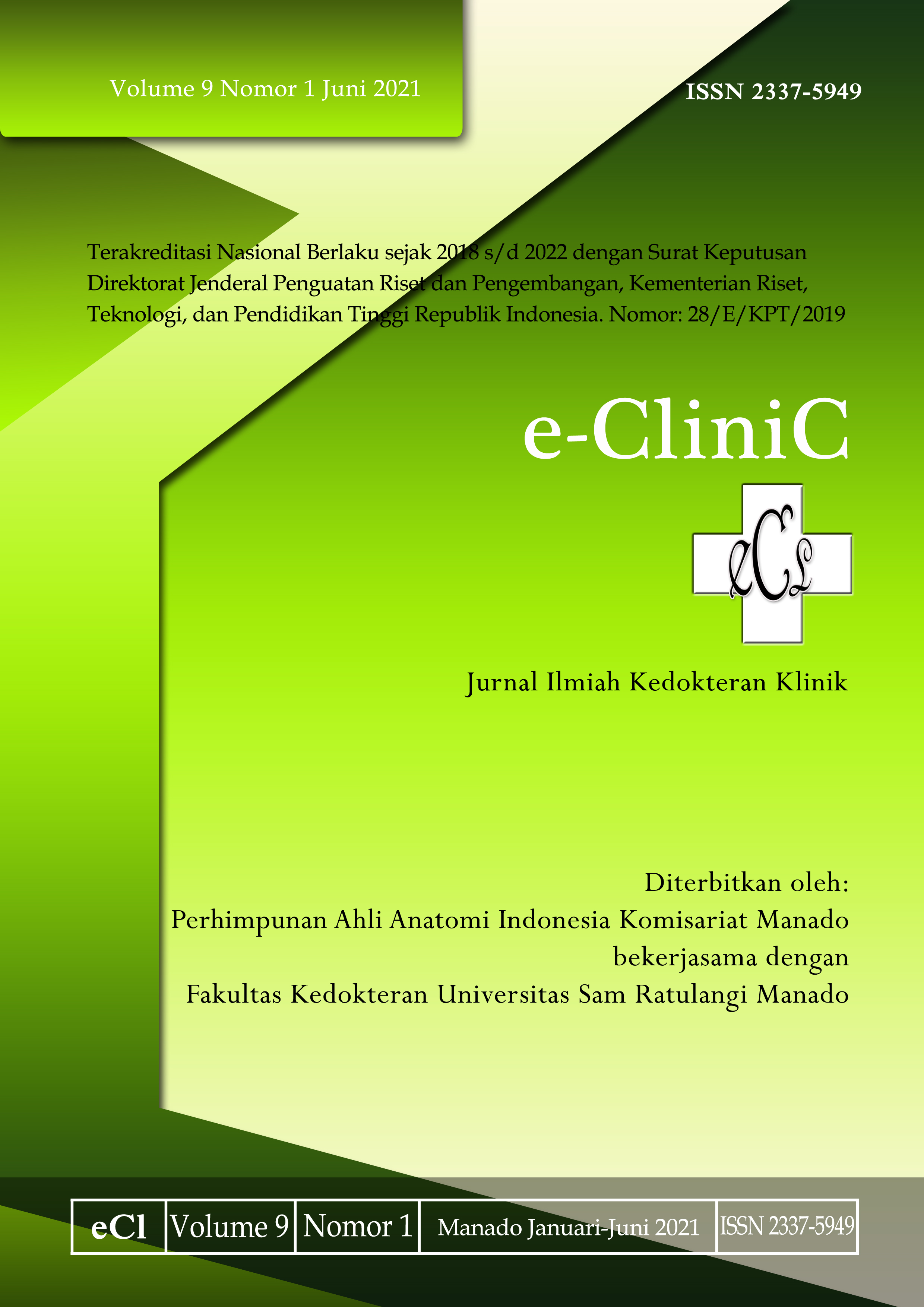Diagnosis Akut Abdomen akibat Peritonitis
DOI:
https://doi.org/10.35790/ecl.v9i1.31853Abstract
Abstract: Peritonitis is defined as inflammation of serosal membrane that lines the abdominal cavity (peritoneum) and the organs contained therein. Secondary peritonitis accounts for 1% of urgent emergent hospital admidssions and is the second leading cause of sepsis in patients in intensive care units globally. Despite the growth in the availability of imaging and laboratory test, the rapid diagnosis of peritonitis remains a challenge for physicians in emergency medicine, surgery, and critical care. This study was aimed to obtain the rapid and appropriate diagnostic methods of secondary peritonitis. This was a literature review study using databases of PubMed, ClinicalKey, and Google Scholar on topics related to the diagnosis of secondary peritonitis. The results showed that there were 12 literatures in this study consisting of 5 review articles, 1 literature review, and 6 prospective studies. The literatures reviewed the diagnosis of secondary peritonitis based on clinical manifestations, physical examination, and the other examinations including laboratory examination, abdominal ultrasound, and abdominal CT scan. In conclusion, the diagnosis of secondary peritonitis is based on clinical manifestation including abdominal pain, rigidity, and rebound tenderness. These sign and symptoms may be supported by laboratory and radiology findings as additional tests if needed. Abdominal ultrasonography is the most practical and non-invasive radiology test for rapid diagnostic in a subgroup of patients with secondary peritonitis whose clinical impression is unclear.                           Â
Keywords: Secondary Peritonitis, Diagnosis of Secondary Peritonitis, Acute Abdomen
Â
Abstrak: Peritonitis adalah inflamasi pada selaput serosa yang membungkus rongga abdomen (peritoneum) dan organ yang terkandung di dalamnya. Peritonitis sekunder menyumbang 1% insiden pada pasien yang masuk di UGD dan merupakan penyebab utama kedua terjadinya sepsis pada pasien di ICU secara global. Di tengah perkembangan ketersediaan pemeriksaan radiologi dan laboratorium yang pesat, diagnosis yang cepat pada peritonitis masih menjadi tantangan bagi para dokter dalam penanganan darurat, pembedahan, dan perawatan pasien kritis. Penelitian ini bertujuan untuk mengetahui metode diagnosis yang cepat dan tepat pada peritonitis sekunder. Jenis penelitian ialah literature review menggunakan database PubMed, ClinicalKey, dan Google Scholar. Hasil penelitian mendapatkan 12 literatur terdiri dari 5 review article, 1 literature review, dan 6 prospective study yang mengulas tentang diagnosis peritonitis sekunder ditegakkan berdasarkan manifestasi klinis, pemeriksaan fisik, dan berbagai pemeriksaan penunjang lainnya yang mencakup pemeriksaan laboratorium, USG abdomen, dan CT scan abdomen. Simpulan penelitian ini ialah diagnosis peritonitis sekunder ditegakkan berdasarkan manifestasi klinis seperti nyeri abdomen, rigiditas, dan rebound tenderness. Tanda dan gejala ini dapat didukung oleh temuan radiologi dan laboratorium sebagai pemeriksaan tambahan bila diperlukan. USG abdomen merupakan pemeriksaan radiologi yang paling praktis dan non-invasif untuk diagnosis cepat pada kelompok pasien peritonitis sekunder dengan kesan klinis yang tidak jelas.
Kata kunci: peritonitis sekunder, diagnosis peritonitis sekunder, akut abdomen
Downloads
How to Cite
Issue
Section
License
COPYRIGHT
Authors who publish with this journal agree to the following terms:
Authors hold their copyright and grant this journal the privilege of first publication, with the work simultaneously licensed under a Creative Commons Attribution License that permits others to impart the work with an acknowledgment of the work's origin and initial publication by this journal.
Authors can enter into separate or additional contractual arrangements for the non-exclusive distribution of the journal's published version of the work (for example, post it to an institutional repository or publish it in a book), with an acknowledgment of its underlying publication in this journal.
Authors are permitted and encouraged to post their work online (for example, in institutional repositories or on their website) as it can lead to productive exchanges, as well as earlier and greater citation of the published work (See The Effect of Open Access).







